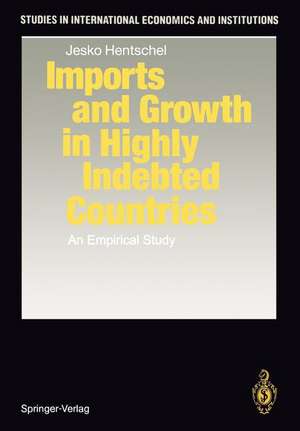Imports and Growth in Highly Indebted Countries: An Empirical Study: Studies in International Economics and Institutions
Autor Jesko Hentschelen Limba Engleză Paperback – 8 mar 2012
Preț: 638.57 lei
Preț vechi: 751.25 lei
-15% Nou
Puncte Express: 958
Preț estimativ în valută:
122.19€ • 127.57$ • 101.13£
122.19€ • 127.57$ • 101.13£
Carte tipărită la comandă
Livrare economică 04-18 aprilie
Preluare comenzi: 021 569.72.76
Specificații
ISBN-13: 9783642467721
ISBN-10: 3642467725
Pagini: 228
Ilustrații: XV, 209 p.
Dimensiuni: 170 x 244 x 12 mm
Greutate: 0.37 kg
Ediția:Softcover reprint of the original 1st ed. 1992
Editura: Springer Berlin, Heidelberg
Colecția Springer
Seria Studies in International Economics and Institutions
Locul publicării:Berlin, Heidelberg, Germany
ISBN-10: 3642467725
Pagini: 228
Ilustrații: XV, 209 p.
Dimensiuni: 170 x 244 x 12 mm
Greutate: 0.37 kg
Ediția:Softcover reprint of the original 1st ed. 1992
Editura: Springer Berlin, Heidelberg
Colecția Springer
Seria Studies in International Economics and Institutions
Locul publicării:Berlin, Heidelberg, Germany
Public țintă
ResearchCuprins
1. Introduction.- 1.1. The debt crisis, imports, and growth.- 1.2. Structure of the study.- 2. The importance of imported factors of production in developing countries.- 2.1. Introductory remarks.- 2.2. The composition of imports.- 2.3. Factors impeding perfect import substitutability.- 2.4. Capital goods.- 2.5. Intermediate goods.- 2.6. Development strategies and the role of imports.- 2.7. Summary.- 3. Import models: issues and problems.- 3.1. Introduction.- 3.2. The theoretical background: imports and growth.- 3.3. The standard import function, foreign exchange availability, and disaggregate import analyses.- 3.4. Empirical studies of imports as factors of production in developing countries.- 3.5. Concluding remarks.- 4. Macroeconomic production functions and elasticities of substitution between imported and domestic factors of production.- 4.1. Introduction.- 4.2. Aggregate production functions and the elasticity of substitution.- 4.3. The nested production function.- 4.4. Summary.- 5. Estimation of elasticities of substitution between domestic and imported means of production.- 5.1. Introductory remarks.- 5.2. Measurement of the domestic price of imported goods.- 5.3. Imported and domestically produced capital goods.- 5.4. Imported intermediate goods.- 5.5. Summary and interpretation of the empirical results.- 6. Imports, growth, and the trade balance: two case studies.- 6.1. Basic remarks about the framework.- 6.2. The Columbian model.- 6.3. The Ecuadorian model.- 6.4. Concluding remarks about the simulations.- 7. Conclusion.- 7.1. Summary of findings.- 7.2. Import vulnerability reconsidered.- Appendices.- A. Statistical tables.- B. The cost function and conditional factor demands for a CES production function.- B.1. Derived factor demands.- B.2. The cost function.- C. Data sources and computational notes.- C.1. Industrial production and price statistics.- C.2. Trade data.- C.3. National income accounting statistics.- C.4. Specific variables used in Chapter 5.- C.4.1. Implicit average effective import taxes.- C.4.2. Real import capacity.- C.4.3. Interest rates.- C.5. Variable defmitions and sources, Chapter 6.- C.6. Computational notes.- References.



















